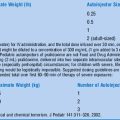Chapter 22 Red Eye
1 What are the dangerous associated features of a “red eye”?
2 What is included in the differential diagnosis for a red eye in a pediatric patient?
16 List the causes of orbital cellulitis
Greenberg MF: The red eye in childhood. Pediatr Clin North Am 50:105–124, 2003.
18 Do all patients with orbital cellulitis require hospital admission?
Yes, orbital cellulitis is a potentially vision- or life-threatening condition.
Greenberg MF: The red eye in childhood. Pediatr Clin North Am 50:105–124, 2003.
19 What are the potential complications of orbital cellulitis?
Vision loss, meningitis, cavernous sinus thrombosis, brain abscess, and death.
20 What are the causative organisms for orbital cellulitis?
Greenberg MF: The red eye in childhood. Pediatr Clin North Am 50:105–124, 2003.
21 How is orbital cellulitis treated?
Greenberg MF: The red eye in childhood. Pediatr Clin North Am 50:105–124, 2003.
22 Which cases of orbital cellulitis are more likely to require surgical intervention and drainage?
Greenberg MF: The red eye in childhood. Pediatr Clin North Am 50:105–124, 2003.
24 What problems can lead to the development of preseptal cellulitis?
 Dacryocystitis (infection of the tear sac)
Dacryocystitis (infection of the tear sac)
 Infections of the oil glands or hair follicles on the lid margins
Infections of the oil glands or hair follicles on the lid margins
Greenberg MF: The red eye in childhood. Pediatr Clin North Am 50:105–124, 2003.
25 Which conditions can mimic periorbital cellulitis?
27 How should you treat a red eye in a contact lens wearer?
1 Red, watery eyes in an infant less than 24–48 hours of age are almost exclusively due to chemical conjunctivitis from topical antibiotics used to prevent ophthalmia neonatorum.
2 A red eye in a contact lens wearer is an emergent problem requiring consultation with an ophthalmologist.
3 Orbital cellulitis is a potentially vision- or life-threatening condition that requires hospital admission and emergent consultation with an ophthalmologist.
4 Orbital cellulitis in children younger than 8 years is often amenable to medical therapy; infections in older children often require surgical intervention.
28 What are the common causes of conjunctivitis?
Infectious (viral, bacterial, or chlamydial), allergic or seasonal, and chemical.
Greenberg MF: The red eye in childhood. Pediatr Clin North Am 50:105–124, 2003.
29 Describe the different types of allergic conjunctivitis
 Seasonal allergic conjunctivitis (hay fever) is associated with itchy, tearing eyes, and relatively minor eye irritation. Chemosis (a blisterlike swelling of the bulbar conjunctivae) is sometimes present. Conjunctival scrapings reveal increased mast cells and eosinophils. Treatment includes topical antihistamines and mast cell–stabilizing agents.
Seasonal allergic conjunctivitis (hay fever) is associated with itchy, tearing eyes, and relatively minor eye irritation. Chemosis (a blisterlike swelling of the bulbar conjunctivae) is sometimes present. Conjunctival scrapings reveal increased mast cells and eosinophils. Treatment includes topical antihistamines and mast cell–stabilizing agents.
 Vernal conjunctivitis is an allergic condition associated with severe itching, tearing, and mucous production and giant papillae of the upper tarsal conjunctiva. Some patients have corneal involvement (keratitis) secondary to scraping by the enlarged papillae. Treatment includes topical antihistamines and mast cell stabilizers. Topical steroids are reserved for the most severe cases, and an ophthalmologist should supervise use. Of affected patients, 20% have permanent vision loss from keratitis.
Vernal conjunctivitis is an allergic condition associated with severe itching, tearing, and mucous production and giant papillae of the upper tarsal conjunctiva. Some patients have corneal involvement (keratitis) secondary to scraping by the enlarged papillae. Treatment includes topical antihistamines and mast cell stabilizers. Topical steroids are reserved for the most severe cases, and an ophthalmologist should supervise use. Of affected patients, 20% have permanent vision loss from keratitis.
 Giant papillary conjunctivitis is similar to vernal conjunctivitis but is secondary to soft contact lens use. It represents a sensitization to components of the lenses and/or cleaning solutions. Treatment includes topical mast cell stabilizers and temporary discontinuation of contact lens use.
Giant papillary conjunctivitis is similar to vernal conjunctivitis but is secondary to soft contact lens use. It represents a sensitization to components of the lenses and/or cleaning solutions. Treatment includes topical mast cell stabilizers and temporary discontinuation of contact lens use.
30 Describe the different types of antiallergy eye drops available for treating ocular allergies
 Ketorolac (a nonsteroidal anti-inflammatory eye drop: may cause stinging on installation)
Ketorolac (a nonsteroidal anti-inflammatory eye drop: may cause stinging on installation)
 Lodoxamide and cromolyn sodium (mast cell stabilizers)
Lodoxamide and cromolyn sodium (mast cell stabilizers)
 Olopatadine (antihistamine and mast cell stabilizer)
Olopatadine (antihistamine and mast cell stabilizer)
 Nedocromil and pemirolast (mast cell stabilizers that inhibit eosinophil activation and chemotaxis)
Nedocromil and pemirolast (mast cell stabilizers that inhibit eosinophil activation and chemotaxis)
 Ketotifen and azelastine (antihistamine, mast cell stabilizing, and eosinophil chemotaxis–inhibiting effects)
Ketotifen and azelastine (antihistamine, mast cell stabilizing, and eosinophil chemotaxis–inhibiting effects)
Greenberg MF: The red eye in childhood. Pediatr Clin North Am 50:105–124, 2003.








































